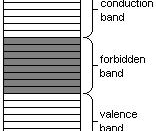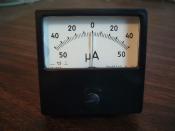How the Length of a Wire Affects Its Resistance
In my physics coursework I am going to investigate the effect of the length of a wire on its resistance. Resistance is the measure of how easy it is for current to flow through a wire. Current is the rate of flow of charge through a conductor, and it is measured in amps using an ammeter.
To help me plan my investigation I have completed a preliminary experiment in which I investigated the effect of the thickness of a wire on its resistance, using three constantan wires and one copper wire. I found that the resistance increased as the thickness of the wire decreased, however, when I did the test with the copper wire I found that it was so unresistant that there would not be a lot of point in conducting my experiment using a copper wire because I would not really be able to compare the results.
I therefore decided to use a wire of a higher resistance; constantan, because it will allow me to get more reliable and comparable results.
Preliminary experiment results:
Wire type/diameter Resistance (W)
Copper 0.2mm 1.8 W
Constantan 0.2mm 9.1 W
Constantan 0.45mm 5 W
Constantan 0.9mm 1.8 W
Diagram:
The things that I will measure and observe are the voltage running through the wire and the current. This will allow me to calculate the resistance of the wire. To calculate the resistance of the wire I will divide the voltage (V) by the current (I), which will give me the resistance in ohms (W).
Equipment:
The equipment that I will use is:
- power pack
- ammeter
- voltmeter
- 30 SWG (diameter) constantan wire
- 1 metre ruler
- leads
- crocodile clips
Method:
This is exactly what I will do:
1) I will set up my experiment as shown in the diagram, with the ammeter connected in series and the voltmeter connected in parallel.
2) I will stretch the wire out along the metre ruler and place the crocodile clips exactly 100cm apart.
3) I will make sure that the voltmeter and ammeter are switched on, and I will then turn on the power pack at a voltage of 2 volts.
4) I will record the voltage and the current, and to calculate the resistance of the wire I will do the calculation voltage divided by current. This will give me the resistance of the wire in ohms.
5) I will repeat the original test for 100cm a further two times, giving me a set of three results. I will then find the average of these results by calculating the mean.
6) I will then repeat the experiment for wire lengths of 20cm, 40cm, 60cm, 80cm, 150cm, 200cm, 250cm and 300cm.
I will make my test fair by keeping some things the same and changing one thing at a time. The things that I will keep the same are the temperature of the wire, by switching off the power pack after collecting each set of results, the voltage setting of the power pack, 2 volts, and the equipment, including the wire, that I will use. The thing that I will change is the length of the section of wire to be tested.
To ensure that my equipment is safe I will switch off the power pack after collecting the necessary results for each length of wire, to prevent overheating of both the equipment that I will be using and the wire. I will also wear safety goggles incase of any sparks or anything else that could damage my eyes.
Prediction:
I predict that as the length of the wire increases, the resistance of the wire will also increase, because there will be more ions and electrons for the free electrons to collide with. I think that if you double the length of a wire, then the resistance will double as well, because it is twice the length of wire, therefore it is also twice as hard for the electrons to travel through the wire, as there are more ions and electrons contained within it. I therefore believe that the increase in resistance of the wire will be directly proportional to the increase in the length of the wire.
Results:
Length of wire (cm) Test no. Voltage (v) Current (a) Resistance (W)
20cm 1 1.05v 0.99a 1.06W
20cm 2 1.04v 0.99a 1.05W
20cm 3 1.04v 1.01a 1.03W
40cm 1 1.35v 0.63a 2.14W
40cm 2 1.31v 0.64a 2.05W
40cm 3 1.40v 0.68a 2.06W
60cm 1 1.51v 0.49a 3.08W
60cm 2 1.46v 0.48a 3.04W
60cm 3 1.57v 0.51a 3.08W
80cm 1 1.62v 0.39a 4.15W
80cm 2 1.60v 0.38a 4.21W
80cm 3 1.70v 0.42a 4.05W
100cm 1 1.72v 0.33a 5.21W
100cm 2 1.67v 0.33a 5.06W
100cm 3 1.80v 0.35a 5.14W
150cm 1 4.35v 0.46a 9.46W
150cm 2 4.36v 0.46a 9.48W
150cm 3 4.49v 0.46a 9.76W
200cm 1 4.64v 0.35a 13.26W
200cm 2 4.69v 0.33a 14.21W
200cm 3 4.63v 0.33a 14.10W
250cm 1 4.74v 0.28a 16.93W
250cm 2 4.72v 0.28a 16.86W
250cm 3 4.78v 0.29a 16.48W
300cm 1 4.96v 0.25a 19.84W
300cm 2 4.78v 0.24a 19.92W
300cm 3 4.68v 0.24a 19.50W
Average Results:
Length of wire (cm) Average voltage (v) Average current (a) Average resistance (W)
20cm 1.04v 1.00a 1.05W
40cm 1.35v 0.65a 2.08W
60cm 1.51v 0.49a 3.07W
80cm 1.64v 0.40a 4.14W
100cm 1.73v 0.24a 5.14W
150cm 4.40v 0.46a 9.57W
200cm 4.65v 0.34a 13.86W
250cm 4.75v 0.28a 16.76W
300cm 4.81v 0.24a 19.75W
To make sure that my measurements and observations were accurate I recorded them to two decimal places and used tested and checked voltmeters, ammeters and power pack.
The pattern that I see in my results is that on my graph they form a straight line and are fairly proportional. I have, however, drawn two different lines of best fit, because my results from wire lengths of 150cm to 300cm are such a big 'jump' away from my other results, that I believe that, as we recorded the two sets of results (20cm-100cm and 150cm-300cm) on different days, we performed the experiment with the longer lengths of wire on the wrong voltage, a higher voltage than 2v. However this doesn't affect my results because on my graph you can still see that both lines are proportional and so both sets of results are true to ohms law.
From my experiment I have found out that as the length of the wire increases, the resistance of the wire increases at a similar rate, therefore, the rate of increase in the length of a wire is directly proportional to the increase in resistance. You could also say that the shorter the wire the lesser the resistance, and the longer the wire the greater the resistance. This shows that my prediction, in which I stated that I believed that the resistance of a wire would increase as its length increases, and that the increase in resistance would be proportional to the increase in the length of the wire, was right.
My results agree with the science that I have learnt because they abide by the rules of ohm's law, which states that the current flowing through a metal conductor is directly proportional to the potential difference across its ends provided the temperature and other physical conditions remain constant (taken from 'Explaining Physics' by Steven Pople). My results also prove the explanation of the free electrons colliding with the stationary ions and electrons in the wire to be correct.
My results were good enough to allow me to find the answer to my investigation. They showed me how the relationship between the length of a wire and its resistance is directly proportional.
My test was fair because I regularly switched off the power pack to keep the temperature of the wire the same, and I used the same equipment all the way through the investigation.
I don't have any odd results that don't fit the pattern. My repeated readings were also all very similar and close to each other. This shows that my all of my results and readings are accurate and that I had no problems with any of the equipment. My measurements were fairly accurate because I recorded them to two decimal places, however, I feel that they could be made more accurate by using a fine pointer instead of crocodile clips to connect the leads to the wire, because when using crocodile clips it is hard to be sure that you are taking the readings from a length of exactly 80cm, or 100cm, or whatever the length of wire to be tested is.
To improve and extend my investigation I would perform the experiment on wires of different materials to see whether they all follow the same pattern, and I would also investigate whether non-metallic conductors follow the same pattern or whether it is different for them and their resistance does not increase in direct proportion with their length.


